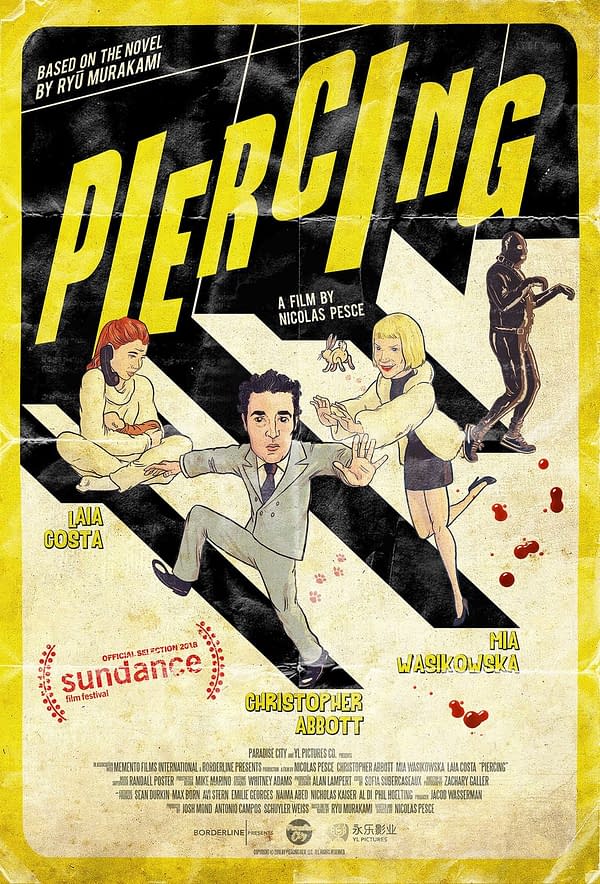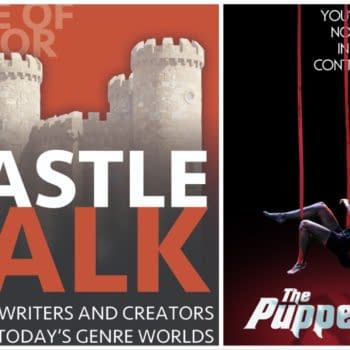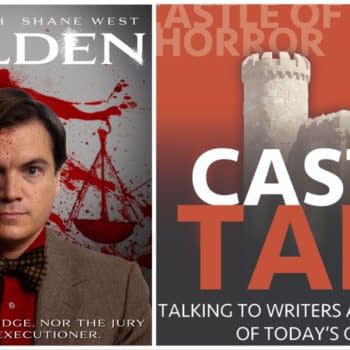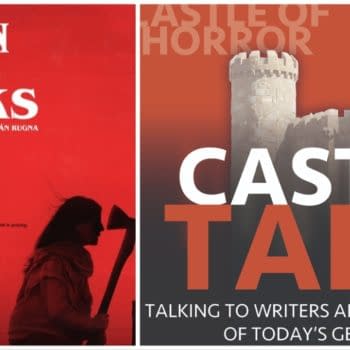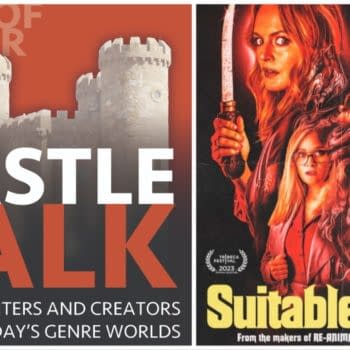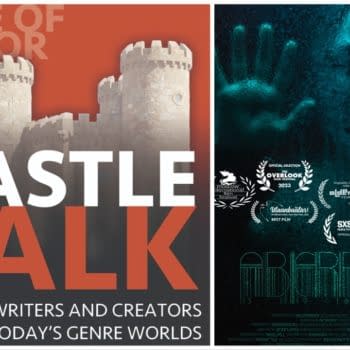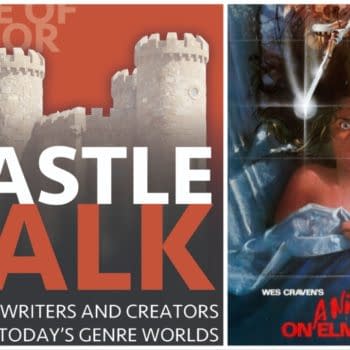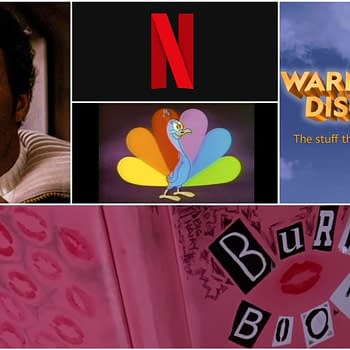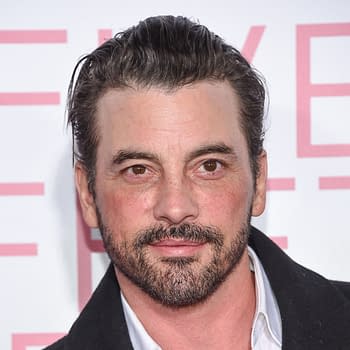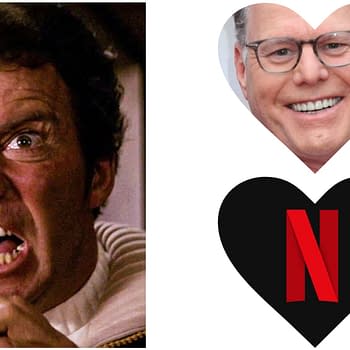Posted in: Movies | Tagged: Castle of Horror Podcast, giallo, mia wasikowska, Nicolas Pesce, Piercing
Interview: Nicolas Pesce on Flipping Giallo's Gender Dynamics in 'Piercing'
At Fantastic Fest 2018, Castle of Horror Co-host Tony Salvaggio sat down to discuss director Nicolas Pesce's new dark genre adaptation of Ryû Murakami's cat and mouse psycho-thriller Piercing.
Pesce shares his ideas on adapting the book, evoking a mood in a minimalistic story and his influences both film and musically to Italian giallo movies.
Warning – Mild Spoilers ahead, and some answers and have been lightly edited for length and clarity.
Tony: So first and foremost, I was curious; as far as adaptations go, what made you pick the book Piercing and go "This is the work I want to adapt."
Nicolas Pesce: When I read the book I found a lot of subject matter that I dealt with in my first movie, and some things that felt really interesting that I wanted to explore. It was tonally something very different than my first movie. It had a lot more of a sense of humor; it was a little bit more playful, a little bit more fun, but still dealing with these really dark things. The book was so asking to be a movie. It's inspired by Western sexy thrillers, like Basic Instinct and author Ryû Murakami was very self-aware of that in the book. It felt like kind of a fun world to play around in. I found the book because I love Audition, the Takashi Miike movie, which is based on a book by the author of Piercing. There's definitely some kind of overlap in both things where you think this poor girl is the victim and she turns out to be the aggressor and that's a fun turn.
Tony: On that same kind of note, how, what's your approach in doing an adaptation? Where do you find that personal space to do the work of adapting for the screen?
Pesce: I think that for me it was about distilling the book, (the book spans more story than the movie does) down to the most essential parts. The real difference in my take on it was stylistically how I made it. I think that it's very much inspired by Italian giallo movies from the seventies. So it was kind of like adapting Murakami by way of giallo.
Tony: So in a movie where for the most part it's two people, what was your process for finding those actors? Because they have to work together well and have chemistry to pull that off.
Pesce: Christopher Abbott who plays Reed was a friend of mine and I had seen him do a lot of roles where he gains a lot of weight and has a beard and looks schlubby and is just like an ordinary blue collar guy, but that's totally not Chris in real life. The dude looks great in a suit, so I wanted to give him an opportunity to do something outside of his comfort zone, less naturalistic, more stylized, more fashionable. He was also involved very early on while I was writing.
Mia Wasikowska came much later in the game and she was kind of an unexpected choice. I don't think any of us thought she'd be like, "Yeah, I want to be an S&M prostitute!" But she did. I think that she brings this really incredible tone to the whole piece and to their relationship. I think that it started with just "Who are actors that I really like and really want to work with and I can see play these roles?" Then there is an element of where you just kinda hope that it's gonna work because you never know… It could work beautifully in rehearsals and then you get on set and it's different. Chris and Mia didn't actually get to rehearse and the first time they met each other was the day that we shot the scene where they meet each other in the movie.
There was kind of a magic in that experience too. It was not intentionally orchestrated; it was just how travel goes. It was kind of an awesome experience for their relationship. They clicked really quickly and, I think, leaned on each other and found playfulness with each other that they could feed off of.
Tony: In this kind of a game of who's the aggressor, who's not—since this was definitely a year that saw a sea change year for women in entertainment—was there anything you felt that you had to pay attention to more, or was it more like this is the movie I want to make and kind of let the chips fall where they may.
Pesce: Well first what I'll say is we made the movie two years ago before a lot of this reckoning started happening. Mostly what it was about for me is, you look at whether it's De Palma or Hitchcock or any of the giallo movies, women in those movies serve a very specific role. They are there to be in danger, to be saved by a guy, or murdered in a really brutally naked way. I think that with my first movie, I was interested in kind of flipping the gender roles and making the killer a woman and, and having it be a woman who kills men brutally, flipping it like that. With this, it was about taking that sexy thriller where you've set it up like here's a damsel in distress, who's going to get hurt by a man in a really brutal way and "She's a prostitute, so I bet you she's going to get naked," and then none of that happens. It's a movie that threatens sex and violence, but never has any sex or violence. That was a sort of fun flip for me. You finish out this movie that's about a guy who calls a prostitute to kill her and he could not be in a worse situation because of that. If anything, with everything that's happened in the industry and in the world, it's this movie about, "Here's what happens if you're a guy like this."
Tony: I was really struck by the cinematography. The movie takes place in only a few locations, but each one has a unique tone. Even within those locations, some scenes are warmer and some scenes are very cold even though they're in the same exact spot. How did you come about those decisions?
Pesce: I think the nature of shooting a movie in so few locations is the challenge of how do you keep it interesting? Especially since half the movie takes place in Jackie's one room apartment. So we had to think about "What's the tone when they're in the kitchen? What's the tone when they're on the couch? What's the tone when they're on the bed?" How do you get between these worlds and how do you make the audience feel different about each of those different parts of the movie. Even the way we played a lot with things like what natural light looks like. The only time you see natural light is the last scene of the movie and it looks very weird. The DP, Zack Galler started his career as a gaffer, so he's got a really detailed attention to lighting and what the effect of lighting is- When it's soft, when it's hard, when it's this color, when it's that color. I think it begins as just a necessity of the fact you're in one room for so long, but then once you start dialing those choices, it becomes something way more interesting
Tony: It definitely found it effective and worth seeing on the big screen to catch the subtleties there. Turning a hotel room (even a posh one) into something that grabs your attention and evokes all those moods stood out to me.
On a different note, can you tell me a bit of how you approached the score considering the subject matter and how it flows?
Pesce: Like I was saying, the movie is very much a giallo movie for me and what we realized quickly while we were editing is, so much of the tone of those movies comes from the music. There is something about that music that is un-recreatable. You look at guys like Tarantino who are taking Ennio Morricone stuff—and Morricone was one of these guys; he started in porn, he did giallo movies and then he did westerns—so much of that tone is baked into the music and there's a quality that's romantic and scary and fun and disco-y and also orchestral. There's just so much going on there. I loved the idea that we were making a movie where, [for example] we're here at Fantastic Fest, the audience is going to get all the references. They're gonna hear Goblin, they're going to know Bruno Nicolai, but elsewhere people don't. People sit there going "What is this music?!" People might know who Dario Argento is, but they may have not seen Deep Red or Tenebrae. If they can hear this music, love it, figure out what it is and then do that reverse engineering and find their way to Argento [that's what I hope]. I found to Takashi Miike by way of Tarantino and I think that if you're a lover of genre, there is a certain responsibility of educating people. If you could do that with your films, I think that's awesome.
Tony: So if you wanted to recommend to people "See these movies after you see my movie." Or "These are the films that you should load up on before seeing Piercing." What would those be?
Pesce: I think that a big influence on this movie was Dario Argento's Bird with the Crystal Plumage, Tenebrae, and Deep Red. You hear the music from those movies in here. I think everyone, when it comes to giallo, (if you know what that is) thinks Argento and thinks Suspiria. Whereas Suspiria is actually kind of an outlier. Giallo movies aren't actually that colorful and aren't that flashy. They do it more on the design usually, whereas Argento did something different with Suspiria. I think the other Argento movies that I mentioned are more traditionally giallo. I think that there's plenty of other filmmakers that don't get the hype because of Argento. Obviously the big ones like Mario Bava and Lucio Fulci, but then also, I love Luigi Bazzoni who made The Fifth Cord and Le Orme. There's a whole world of this stuff that you could go so far down the rabbit hole on these movies. I think that if I can begin to give people a little taste of what's out there in this world, that's awesome.
Tony: So you do these junkets and people ask you all these questions when you're presenting your film, is there ever something where you're like, "There is this is one thing I like and no one asked me about this thing that I feel is really important and I can't believe that nobody asked me about that because it's the core, but it's been glossed over."
Pesce: No, I think, and perhaps it's because of how loudly I wear my references on my sleeves or like how loud the filmmaking is. To me this movie is a lot about design and fashion and music and there's a lot of these stylistic things which come from the giallo stuff, but also there's a lot of practical makeup effects in there as well. However, I'm in a movie that's so minimal. I think that it's nice that people see things that I'm doing.
I'm someone who likes to filmmaking to be seen, whether I'm a viewer or a filmmaker. I like to see the filmmaking. I'm not as attracted to super-naturalistic stuff. Um, I want to see that you're trying cool things and doing loud stuff. The more stylized the better. We used a ton of miniatures in the movie to build the city. All the locations are sets, there's this, all this artificial filmmaking stuff in the movie that I think is really fun. The cars are rear screen projection. It's all the other good old shit that people don't do anymore.
Tony: I was struck by that so having miniatures and all the nice practical work, practical is always going to be best. So thanks so much for talking with us, all the things you mentioned are what those of us on The Castle of Horror Podcast love. Good luck with the film!
Check out Piercing in theaters, digital, and OnDemand starting February 1st, 2019.


